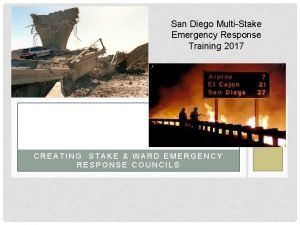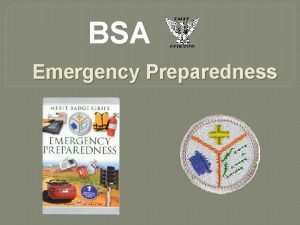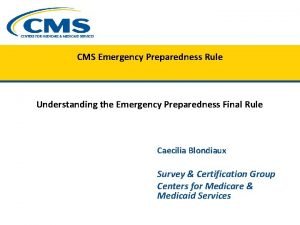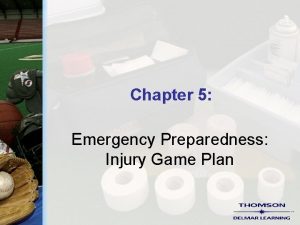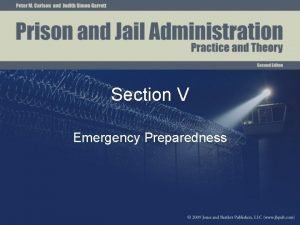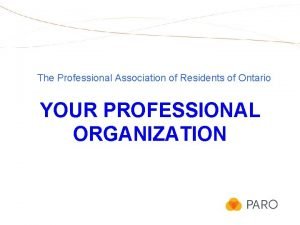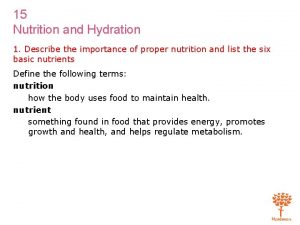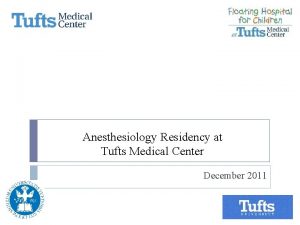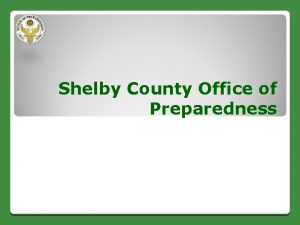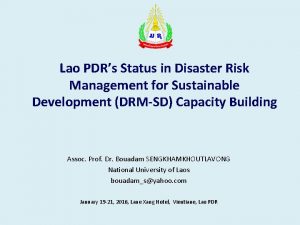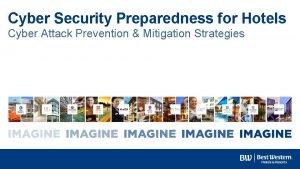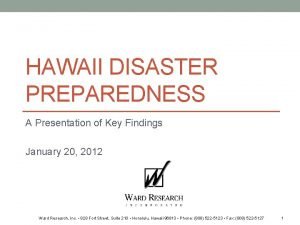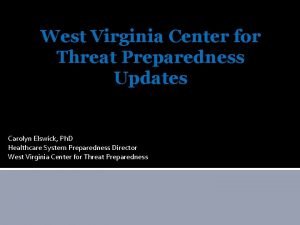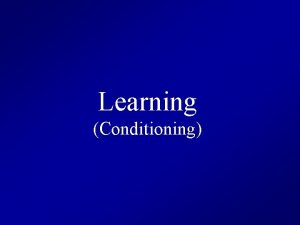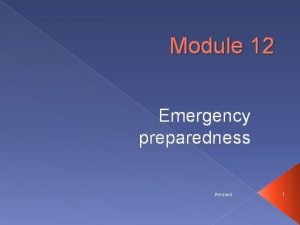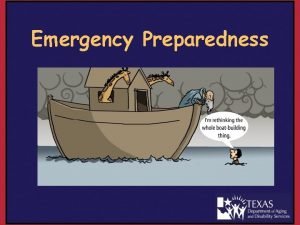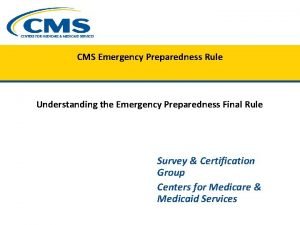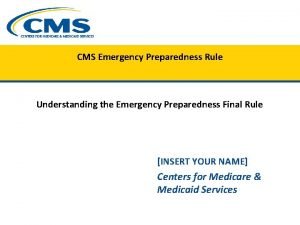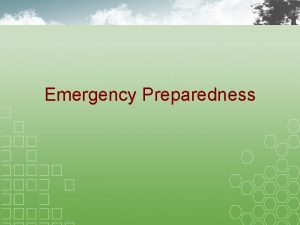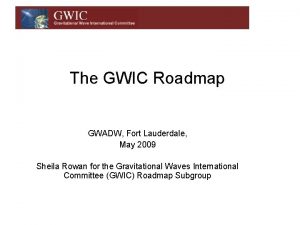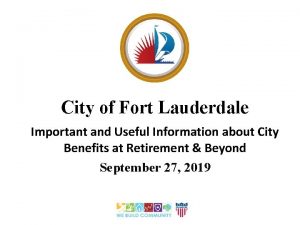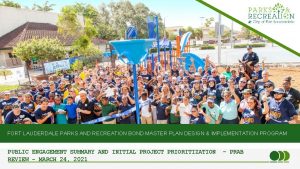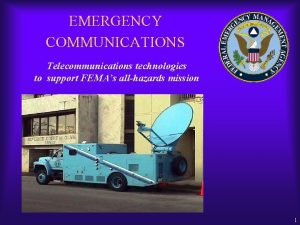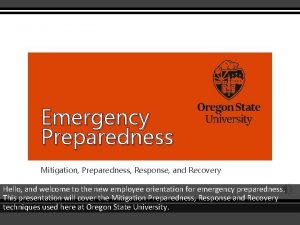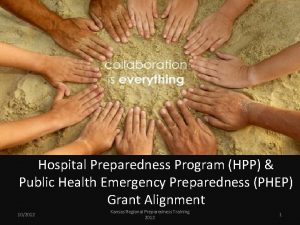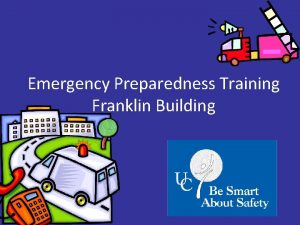AllHazards Emergency Preparedness for Residents Fort Lauderdale Domestic






































































- Slides: 70

“All-Hazards” Emergency Preparedness for Residents Fort Lauderdale Domestic Preparedness & Emergency Management Bureau

Quote - George Santayana “PEOPLE WHO FORGET THE LESSONS OF THE PAST ARE CONDEMNED TO REPEAT THEM”

Why Prepare? • Disasters can happen at any time • Mass destruction can leave you cutoff for days • It’s important to surviving and recovering

“All-Hazards” Approach What is a hazard? A situation or condition that presents the potential for causing: • Fatalities • Injuries • Property damage • Infrastructure damage • Agricultural loss • Interruption of business

Natural Hazards • • • Floods Hurricanes Thunderstorms/lightning Tornadoes Extreme heat Fires

Specific Hazards -Terrorism • • • Explosions Biological threats Chemical threats Nuclear blasts Radiological dispersion device events

Floods • • Most common hazard in the US Floods are not alike Some develop slowly (over a period of days) Flash floods – develop quickly (wall of roaring water that carries rocks, mud and debris) • Overland flooding – levee breached


Flood - Protective Measures • • • Before Avoid building in a floodplain Elevate furnace, water heaters if susceptible Install “check valves” in sewer traps Construct barriers (levees, beams, floodwalls) Seal basements with waterproofing compounds

Floods Continued… • • During Listen to radio or TV for information Be aware that flash flooding can occur Evacuate if told to do so (turn off utilities) After Avoid floodwaters (contaminated) Avoid moving water Be aware of where floodwaters receded Return home only when authorities advise

Tornadoes • • • Nature's most violent storm Appears as a rotating, funnel-shape cloud Strike quickly (little or no warning) Moves SW to NE – usually Most likely to occur between 3 pm and 9 pm Peak season – Southern states (March – May) – Northern states (May – July)


Enhanced Fujita Scale (EF Scale) EF Rating 3 Second Gust (mph) 0 65 - 85 1 86 - 110 2 111 - 135 3 136 - 165 4 166 - 200 5 Over 200

Tornado Warning • Seek shelter immediately - safe room • Never stay in a vehicle, trailer or mobile home • If outside lie flat in a ditch or depression and cover your head with your hands • Never outrun a tornado in a car or truck • Watch for flying debris

Protective Measures - Tornadoes • Listen to NOAA Weather Radio or TV news • Look for approaching storms • Look for danger signs • Dark, greenish sky • Large hail • Large, dark, low-lying rotating clouds • Loud roar, similar to freight train

Preparing a Safe Room • • Interior room on the first floor Built to withstand high winds and flying debris Must be adequately anchored to resist uplift Walls, ceiling, and door must withstand wind pressure and resist penetration Examples • Apartments – bathroom • One-story home – walk-in closet • Two-story home – first floor bathroom

Hurricanes and Tropical Storms • Tropical cyclone that forms in the tropics • Accompanied by thunderstorms • Northern hemisphere – counter-clockwise circulation • Atlantic and Gulf of Mexico coastal areas • Season – June 1 thru November 30 • Peak season – mid-August to late October • Five categories based on wind speed, central pressure and damage potential

Saffir-Simpson Scale Category Max Sustained Wind Speed (MPH) Minimum Surface Pressure (Millibars) Storm Surge (Feet) 1 74 – 95 Greater than 980 3 -5 2 96 – 110 979 – 965 6– 8 3 111 – 130 964 – 945 9 - 12 4 131 – 155 944 – 920 13 - 18 5 155 + Less than 920 19 +

Primary Damages from Hurricanes Water and Wind Water – by wind direction enters through gable ends, soffit vents, poorly sealed windows (mold/mildew) Wind – damages homes by increasing pressure and causing uplift forces on the roof

Tropical Cyclone Watch and Warning • Tropical Storm or Hurricane Watch – 48 hours before storm • Tropical Storm or Hurricane Warning – 36 hours before storm

Before a Hurricane – Insurance Check • • Review your policy annually Artwork, guns may not be covered Photograph items, keep receipts Send a copy out of state (family/friends) • FL Department of Financial Services – Consumer Help Line – 1 -877 -693 -5236

Flood Insurance • Flood insurance separate from homeowners or wind/storm • National Flood Insurance Program – 1 -888 -379 -9531 – www. FEMA. gov

Special Needs Registry • Disabled, frail, health issues 954 -831 -4000 • http: //www. broward. org/registry • Fort Lauderdale GIS mapping Register family members and/or friends that may need the extra care they need!

Protective Measures – Hurricane (Before) • Storm shutters or 5/8” marine plywood over windows • Tape does not prevent windows from breaking • Clear loose or clogged rain gutters and downspouts • Bring in or secure loose outdoor objects • Take photos of personal belongings


Evacuation Plan • • Plan for two (2) routes to evacuate Stay with family or friends Stay in a hotel (inland or another County) Communications Plan • Out of state contact • Have two (2) local meeting places • Outside neighborhood (church, school) • Everyone has up to date phone numbers

Evacuation - Hurricane • • Directed by local authorities If you live in a mobile home If you live in a high-rise building If you live on the coast, on a floodplain, near a river, or inland waterway • If you fear you are in danger


Broward County Shelters HURRICANE SHEERS

Regional Hurricane Shelters • Lyons Creek Middle School 4333 Sol Press Blvd. , Coconut Creek 33073 • Coral Glades High School 2700 Sportsplex Dr. , Coral Springs 33065 • Monarch High School 5050 Wiles Rd. , Coconut Creek 33073 • Pompano Beach High School 600 N. E. 13 Ave. , Pompano Beach 33060 • Rock Island/Arthur Ashe School 1701 N. W. 23 Ave. , Fort Lauderdale, 33311

Regional Hurricane Shelters • Watkins Elementary School 3520 S. W. 52 Ave. , Pembroke Park, 33023 • Park Lakes Elementary School 3925 N. State Road 7, Lauderdale Lakes 33319 • Plantation Elementary School 651 N. W. 42 Ave. , Plantation 33317 • Fox Trail Elementary School 1250 Nob Hill Road, Davie 33324 • Falcon Cove Middle School 4251 Bonaventure Blvd. , Weston 33332

Regional Hurricane Shelters • Silver Trail Middle School 18300 Sheridan St. , Pembroke Pines 33331 • West Broward High School 500 N. W. 209 Ave. , Pembroke Pines, 33029 • Everglades High School 17100 S. W. 52 Ave. , Miramar 33027 • New Renaissance Middle School 10701 Miramar Blvd. , Miramar 33025

Pet Friendly Shelter • Millennium Middle School 5803 N. W. 94 Ave. , Tamarac 33321 Pre-Registration is Required Humane Society 954 -989 -3977

Unable to Evacuate • Stay indoors and away from windows and glass doors • Close all interior doors – secure & brace external doors • Keep curtains and blinds closed • Take refuge in a small interior room, closet or hallway (lowest level) • Lie on the floor under a table or other sturdy object

What to do during a hurricane • Listen to radio or TV for information • Turn refrigerator to coldest setting/keep doors closed • Turn off utilities/propane if instructed • Avoid using the phone (emergencies only) • Ensure supply of water for sanitary purposes Cleaning and flushing toilets Fill up bathtub/large containers with water

After a Hurricane • • • Be careful when venturing outside Look out for downed power lines Stay out of standing water Take photos of the property Ensure all family members are accounted for Monitor local media for all clear from emergency officials • Listen to 1610 AM • 954 -828 -8888 (Hurricane Hotline)

Run from water, hide from the wind…

Wind Dangers. Tropical storm-force winds are strong enough to be dangerous to those caught in them. For this reason, emergency managers plan on having their evacuations complete and their personnel sheltered before the onset of tropical storm-force winds, not hurricane-force winds. Hurricane-force winds can easily destroy poorly constructed buildings and mobile homes. Debris such as signs, roofing material, and small items left outside become flying missiles in hurricanes. Extensive damage to trees, towers, water and underground utility lines (from uprooted trees), and fallen poles cause considerable disruption.

Winds continued… High-rise buildings are also vulnerable to hurricane-force winds, particularly at the higher levels since wind speed tends to increase with height. If you live in a high-rise building and an evacuation order has been issued. Evacuate. If there is no evacuation order for your area, recent research suggests you should stay below the tenth floor, but still above any floors at risk for flooding. It is not uncommon for high-rise buildings to suffer a great deal of damage due to windows being blown out if there is no window protection. Consequently, the areas around these buildings can be very dangerous.

Downtown

Things to do during a Watch / Warning • Keep a full tank of gas in your car • Monitor local media for evacuation order from emergency officials • Watch Channel 78 • Listen to 1610 AM • Fort Lauderdale Hurricane Hotline • 954 -828 -8888

Basic Disaster Supplies Kit • 5 -7 day supply of nonperishable food • 5 -7 day supply of water – 1 gal/person, per day • Portable, battery powered radio or TV and extra batteries • Flashlight and extra batteries • First aid kit • Matches in a waterproof container • • • Sanitation/hygiene items Whistle Extra clothing Can opener (hand) Photocopies credit/ID cards • Cash and coins • Special needs items (meds) • Items for infants/pets

Kit Locations Home • Essential food, water and supplies for 3 days • Keep in designated area and ready to go Work • One container – “grab and go” [food/water] • Comfortable shoes Car • Flares, jumper cables, seasonal supplies • Food and water, first aid kit

Pet Plan • • • Pet friendly hotels Extra food, water, medicines Collar with id, leash Up to date vaccination records Photograph Toys, bedding Towels Clean up materials (bags, disinfectant) Carrier

Water Safety • Monitor the local media for boil water alerts • Throw away all food, cosmetics, or medications that have come into contact with flood waters.

Generator Safety • Follow the instructions • NEVER use portable generators indoors, even if you have ventilation • If you feel sick, dizzy, or weak while using a generator, get fresh air immediately • Turn the generator off & let it cool before refueling • Plug appliances directly into generator or use heavy-duty outdoor rated extension cord • Never try to power the house wiring by plugging the generator into a wall outlet

Thunderstorms and Lightning • Occur singly, in clusters or in lines • Produce heavy rain for a brief period (30 minutes to an hour) • Warm, humid conditions are favorable Lightning • 300 people injured & 80 killed per year • May occur as far as 10 miles away from storm • Chances of being struck: 1 in 600, 000

Protective Measures - Thunderstorms • Postpone outdoor activities • Move indoors • Avoid showering or bathing (plumbing and bathroom fixtures can conduct electricity) • Cordless and cell phones are safe to use • Unplug appliances, computers reduce power surges • Listen to NOAA radio or battery operated radio for information

Extreme Heat – Protective Measures • • Install window air conditioners snugly; insulate Service A/C units Install window tinting Weather-strip doors and sills to keep cool air in

During a Heat Emergency • • • Stay indoors as much as possible Limit exposure to the sun Eat well-balanced, light, & regular meals Avoid using salt Drink plenty of water Limit alcohol use Dress in lightweight clothing Never leave children in closed vehicles Avoid strenuous work

First-Aid for Heat Induced Illnesses Condition Symptoms First Aid Heat Cramps Painful spasms (leg and abdominal muscles); heavy sweating Move to cooler location Lightly stretch Sip cool water every 15 minutes Heat Exhaustion Heavy sweating; cool, pale skin; weak pulse; dizziness; N/V; headache Lie down in cool location Apply cool wet cloths Give sips of water Seek medical attention if vomiting occurs Heat Stroke Hot, red, dry skin; weak pulse; rapid and shallow breathing Call 9 -1 -1 immediately Move to cooler environment Remove clothing Cool with water (sponge, sheet)

Health Monitor your and your friends’ and family’s physical and mental health.

Fires

Fire • More than 4, 000 Americans die • 25, 000 people are injured • Direct property loss estimated @ $8. 6 billion annually • Spreads quickly • In two minutes – life threatening • In five minutes – residence can be engulfed • Heat and smoke are most dangerous

Protective Measures - Before a Fire • • Install smoke alarms/sprinklers Test and clean smoke alarms once a month Replace batteries at least once a year Replace smoke alarms every 10 years Establish an escape route and practice Ensure windows are not nailed or painted shut Teach family members to stay low to the floor when escaping

Protective Measures Continued… • Never smoke near flammable liquids or in bed • Be careful when using alternative heating sources • Keep open flames away from walls, furniture, drapery • Place a screen in front of fireplace • Have heating units inspected and cleaned • Make sure extension cords or wiring does not run under rugs, over nails or across high traffic areas

Protective Measures During a Fire • If your clothes catch on fire – STOP, DROP and ROLL until fire is extinguished • Check doors for heat before you open them • Hot door or cool door • Close doors behind you • Go outside and meet in a pre-determined spot • Do not re-enter • Call 9 -1 -1

Fire Safety in High-Rise Buildings “Be Prepared” • Know where to find your building’s fire alarms and learn how to use them • In case of fire dial 9 -1 -1 • Learn the sound of your building’s fire alarm system • Make sure everyone in your home knows where to go if the fire alarm sounds & practice your escape plan together

Fire Safety in High-Rise Buildings “Be Prepared” • Your building manager should post evacuation plans where everyone can see them • Know at least two escape routes from every room in your apartment or condominium & learn every exit from your building • Count the doors between your living unit & the two nearest exits • You may have to escape a fire in the dark

Fire Safety in High-Rise Buildings “When Exiting a High-Rise in a Fire” • Exit quickly, closing all doors behind you to slow the spread of fire and smoke • If you encounter smoke or flames, use another escape route • If you have to escape through smoke, crawl low since heat and smoke rise • Cleaner air will be found one to two feet above the floor

Fire Safety in High-Rise Buildings “When Exiting a High-Rise in a Fire” • Test doors before you open them • Kneel or crouch, reach up high and touch the door, the knob and the space between the door and its frame with the back of your hand • If the door feels cool, open it carefully and be ready to slam it shut if smoke or heat rushes in

Fire Safety in High-Rise Buildings “When Exiting a High-Rise in a Fire” • Never use an elevator during a fire. It may stop between floors or at a floor where the fire is • Go directly to a stairwell that’s free of smoke, heat or flame • Once you are out, tell the fire-rescue department if you know of anyone trapped in the building • Do not go back inside for any reason until firefighters tell you it’s safe

Fire Safety in High-Rise Buildings “If Unable to Leave a High-Rise” • If possible go to a room with an outside window and a telephone closing all doors between you and the fire • Use duct tape or stuff the cracks around the door with wet towels, rags or bedding and cover vents to keep the smoke out of the room

Terrorism Definition: Use of force or violence against persons or property in violation of the criminal laws of the United States for purposes of intimidation, coercion, or ransom.


General Guidelines • Be aware of your surroundings • Move or leave if you feel uncomfortable or if something does not feel right • Take precautions when traveling • Learn where emergency exits are in buildings • Be prepared to do without services you normally depend on

Biological & Chemical Threats • Ensure your immunizations are up-to -date • Install HEPA filters for HVAC • Close windows and doors • Turn off HVAC • Listen to TV and radio for further instructions

Nuclear and Radiological Attacks (RDD) • No way of knowing how much warning there will be • Listen to local TV and radio for instructions • Turn off HVAC, close windows • Seal windows and external doors with duct tape • Ensure you emergency supply kit is up-to-date

Resources Phone Numbers • FEMA 1 -800 -621 -FEMA (3362) • AT&T 1 -877 -737 -2478 • TECO Gas 1 -877 -832 -6747 • County Hurricane Hotline • 954 -831 -4000

Thank you
 University of new mexico internal medicine residency
University of new mexico internal medicine residency Chapter 36 emergency preparedness and protective practices
Chapter 36 emergency preparedness and protective practices Stake emergency preparedness plan
Stake emergency preparedness plan Bsa emergency preparedness
Bsa emergency preparedness Cms emergency preparedness final rule
Cms emergency preparedness final rule National radiological emergency preparedness conference
National radiological emergency preparedness conference Chapter 5 emergency preparedness injury game plan
Chapter 5 emergency preparedness injury game plan Chapter 36 emergency preparedness and protective practices
Chapter 36 emergency preparedness and protective practices Il y a fort longtemps
Il y a fort longtemps Je suis fort plus que vainqueur
Je suis fort plus que vainqueur Qualifying shift paro
Qualifying shift paro Tourism involving non-residents of the given area.
Tourism involving non-residents of the given area. Dr sarah gernhart
Dr sarah gernhart St louis family medicine residency
St louis family medicine residency Informed delivery for business mailers
Informed delivery for business mailers Uw neurosurgery residents
Uw neurosurgery residents Nutrition and hydration chapter 15
Nutrition and hydration chapter 15 Tufts neurology residency
Tufts neurology residency Uihc internal medicine residency
Uihc internal medicine residency Uf neurology residents
Uf neurology residents Uthscsa family medicine residency
Uthscsa family medicine residency Umass internal medicine residency
Umass internal medicine residency Personal care skills chapter 6
Personal care skills chapter 6 Dr megan prickett
Dr megan prickett Karl suure impeerium
Karl suure impeerium Williamson medical center pharmacy residency
Williamson medical center pharmacy residency Famous yonkers residents
Famous yonkers residents Global pandemic preparedness
Global pandemic preparedness Shelby county office of preparedness
Shelby county office of preparedness Conclusion in disaster management
Conclusion in disaster management Implementing nfpa 1600 national preparedness standard
Implementing nfpa 1600 national preparedness standard Data breach preparedness
Data breach preparedness Implementing nfpa 1600 national preparedness standard
Implementing nfpa 1600 national preparedness standard Biological preparedness
Biological preparedness Preparedness mitigation response recovery
Preparedness mitigation response recovery Operant conditioning
Operant conditioning Hawaii disaster preparedness
Hawaii disaster preparedness Biological preparedness
Biological preparedness West virginia center for threat preparedness
West virginia center for threat preparedness Biological preparedness
Biological preparedness Dog bite pictures
Dog bite pictures Disaster management
Disaster management Promoting family earthquake preparedness
Promoting family earthquake preparedness Tack för att ni lyssnade
Tack för att ni lyssnade Tes debattartikel
Tes debattartikel Tobinskatten för och nackdelar
Tobinskatten för och nackdelar En lathund för arbete med kontinuitetshantering
En lathund för arbete med kontinuitetshantering Atmosfr
Atmosfr Var finns arvsanlagen
Var finns arvsanlagen Verifikationsplan
Verifikationsplan Rådet för byggkompetens
Rådet för byggkompetens Lufttryck formel
Lufttryck formel Presentera för publik crossboss
Presentera för publik crossboss Kung dog 1611
Kung dog 1611 Vad är densitet
Vad är densitet Nationell inriktning för artificiell intelligens
Nationell inriktning för artificiell intelligens Tack för att ni har lyssnat
Tack för att ni har lyssnat Smärtskolan kunskap för livet
Smärtskolan kunskap för livet Vad är referatmarkeringar
Vad är referatmarkeringar Sten karttecken
Sten karttecken Fimbrietratt
Fimbrietratt Frgar
Frgar Multiplikation med uppställning
Multiplikation med uppställning Delegerande ledarskap
Delegerande ledarskap Toppslätskivling effekt
Toppslätskivling effekt Elektronik för barn
Elektronik för barn Särskild löneskatt för pensionskostnader
Särskild löneskatt för pensionskostnader Borra hål för knoppar
Borra hål för knoppar Bris för vuxna
Bris för vuxna Bra mat för unga idrottare
Bra mat för unga idrottare Etik och ledarskap etisk kod för chefer
Etik och ledarskap etisk kod för chefer


